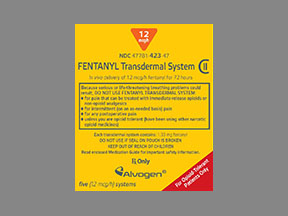
Duragesic-12 Coupons & Savings Card – Discount Prices from $83.67
Brand for: Fentanyl
My prescription
Edit
12MCG/HR, Fentanyl (30 Patch 72 Hours)
Select pharmacy

CVS
$83.67
COUPON PRICE
Walgreens
$154.32
COUPON PRICE
Rite Aid
$287.28
COUPON PRICE
Albertsons
$342.92
COUPON PRICEDuragesic-12 savings card
Show this card to your pharmacist
CVS
$83.67
BIN
ID
PCN
GRP
019876
LH94881BB1
CHIPPO
LHX
Powered by
More prescriptions for pain
More prescriptions for pain
Duragesic-12 dosage forms
| Dosage | Quantity | Price from | Per unit |
|---|---|---|---|
| 12MCG/HR | 30 Patch 72 Hours | $83.67 | $2.79 |
Our price history data is based on aggregated prescription data collected from participating pharmacies in America. Our prescription data updates daily to reflect the latest price changes. If you notice a missing data point, it means there wasn't sufficient data available to generate a monetary value for that date.
Duragesic-12 Warnings
Fentanyl is a powerful opioid medication associated with significant risks and should be used with caution. Below are important safety guidelines and warning information for patients and healthcare providers to consider:
Risk of Abuse and Addiction: Fentanyl has a high potential for misuse, addiction, and abuse, which can result in overdose and death. It should only be used by individuals who are opioid-tolerant and prescribed the correct dosage.
Breathing Complications: Fentanyl can lead to severe and potentially fatal respiratory depression. This risk is heightened when starting the medication, changing doses, or using it improperly. Signs of breathing issues include slow or shallow breathing, confusion, extreme tiredness, and bluish skin or lips. Immediate medical attention is required if these symptoms occur.
Interactions with Other Substances: Combining fentanyl with alcohol, benzodiazepines, or other drugs that depress the central nervous system can lead to serious side effects, including death. Patients should inform their healthcare provider of all medications they are taking.
Accidental Exposure: Care must be taken to prevent accidental exposure, especially in children and pets. Used patches still contain active medication and can be hazardous. Proper disposal is critical.
Heat Exposure: Avoid exposing the fentanyl patch to heat sources such as heating pads, electric blankets, or excessive sunbathing, as this can increase drug release and risk of overdose.
Pregnancy and Breastfeeding: Use of fentanyl during pregnancy can pose risks to the unborn child, including dependency and withdrawal symptoms after birth. Pregnant individuals should only use the drug if absolutely necessary and under close medical supervision.
Withdrawal and Dependence: Long-term use can lead to physical dependence. Abrupt cessation may cause withdrawal symptoms. Dose adjustments should be carried out under medical guidance.
Serotonin Syndrome: Fentanyl may interact with medications that increase serotonin levels, leading to a potentially life-threatening condition known as serotonin syndrome. Symptoms include confusion, rapid heart rate, and muscle stiffness, requiring emergency medical attention.
Blood Pressure and Heart Rate: Fentanyl can cause low blood pressure and slow heart rate, especially when initiating treatment. Patients should be cautious when standing from a sitting or lying position to prevent dizziness or fainting.
Adrenal Insufficiency: Long-term use may result in low adrenal hormone levels. Symptoms like fatigue, nausea, and dizziness should be reported to a healthcare provider.
In the event of a suspected overdose, naloxone (a medication that can reverse opioid effects) should be administered immediately, and emergency services should be contacted. Always follow your healthcare provider's instructions regarding fentanyl use, and never change the dosage without medical approval.
Duragesic-12 Side Effects
When using this medication, some individuals may experience mild side effects such as nausea, vomiting, constipation, lightheadedness, dizziness, drowsiness, and headaches. These effects might diminish as your body adjusts to the medication. To mitigate constipation, consider increasing dietary fiber, staying hydrated, and engaging in regular exercise. If dizziness or lightheadedness occurs, try rising slowly from sitting or lying positions.
In some cases, mild irritation, itching, or redness may develop at the application site. A few people might notice increased sweating, tiredness, feelings of cold, or difficulty sleeping. These reactions are generally mild but should be monitored.
Though rare, there are serious side effects that require immediate medical attention. These include severe breathing difficulties, seizures, significant drowsiness, or difficulty waking up. Another serious concern is serotonin syndrome, a condition that may occur if you are taking other medications that increase serotonin levels. Watch for symptoms such as a rapid heartbeat, hallucinations, loss of coordination, severe nausea, or unexplained fever.
Additionally, a severe allergic reaction is possible, characterized by rash, swelling (particularly of the face, tongue, or throat), severe dizziness, or trouble breathing. If you experience any of these, seek medical help immediately. For any other side effects not listed, consult your doctor or pharmacist. Remember, most people using this medication do not experience serious side effects, but it is important to be aware of them.
Duragesic-12 Interactions
When using a fentanyl patch, it is crucial to inform your healthcare provider about all other medications or supplements you are taking, as there are many potential interactions. Certain drugs can significantly affect how fentanyl works by altering its elimination from the body. These include azole antifungals (like Itraconazole, Ketoconazole), calcium channel blockers (such as diltiazem, Verapamil), HIV protease inhibitors (such as nelfinavir), macrolide antibiotics (such as Erythromycin), and others including Mifepristone and Nefazodone.
Additionally, the concurrent use of fentanyl with MAO inhibitors (such as isocarboxazid, Linezolid, phenelzine, among others) can lead to severe, potentially fatal reactions. It is recommended to avoid MAO inhibitors during treatment and for two weeks prior. Your doctor will guide you on the appropriate timing for these medications.
The risk of severe side effects like slow or shallow breathing and extreme drowsiness increases when fentanyl is combined with other substances that cause drowsiness or breathing issues. These include other opioids (like codeine, hydrocodone), alcohol, marijuana, sleep or anxiety medications (such as Alprazolam, Lorazepam), muscle relaxants (like Carisoprodol), and antihistamines (such as Cetirizine, diphenhydramine). Always check medicine labels for ingredients that may cause drowsiness and consult your pharmacist for safe use.
Moreover, using fentanyl with drugs that increase serotonin can heighten the risk of serotonin syndrome, a potentially life-threatening condition. These drugs include certain antidepressants (SSRIs like Fluoxetine, SNRIs like Duloxetine), St. John's wort, and recreational drugs like MDMA.
Finally, fentanyl can interfere with specific lab tests, such as those measuring amylase and lipase levels, leading to inaccurate results. It is essential to inform laboratory personnel and all your doctors about your use of fentanyl.
What is DURAGESIC used for?
Duragesic is used for managing severe chronic pain in patients who require continuous, long-term opioid treatment and for whom alternative treatment options are inadequate. It is a transdermal patch that delivers fentanyl, a potent opioid analgesic, through the skin.
Is DURAGESIC discontinued?
Duragesic, a brand name for the fentanyl transdermal patch, has not been discontinued. It is still available by prescription for managing severe chronic pain in patients who require continuous opioid analgesia. However, availability may vary by location and specific formulations. It is important to consult with a healthcare provider or pharmacist for the most current information regarding its availability.
Where do you apply DUROGESIC?
DUROGESIC, a transdermal patch, should be applied to a flat, non-irritated, and non-hairy area of the skin on the upper body or upper arm. The skin should be clean and dry before application. It is important to avoid areas with cuts, irritation, or excessive hair. If necessary, hair can be clipped but not shaved. The patch should be pressed firmly in place with the palm of the hand for about 30 seconds to ensure it adheres properly.
Is DURAGESIC a schedule 2 drug?
Yes, DURAGESIC, which contains fentanyl, is classified as a Schedule II controlled substance in the United States. This classification indicates that it has a high potential for abuse, with use potentially leading to severe psychological or physical dependence.
What are the side effects of DURAGESIC?
Duragesic, which is a brand name for fentanyl transdermal patches, can have several side effects. Common side effects include nausea, vomiting, constipation, dry mouth, drowsiness, dizziness, and headache. More serious side effects may include shallow breathing, slow heartbeat, confusion, severe drowsiness, and fainting. It is important for individuals to contact their healthcare provider if they experience any severe or concerning symptoms.
